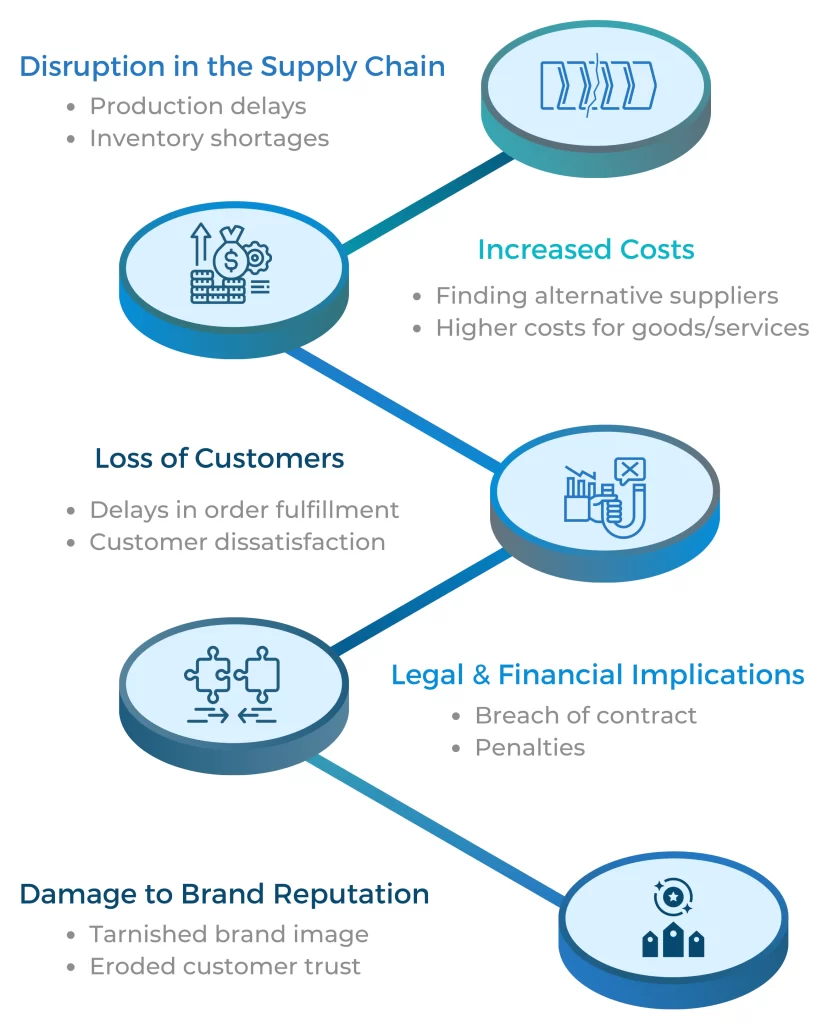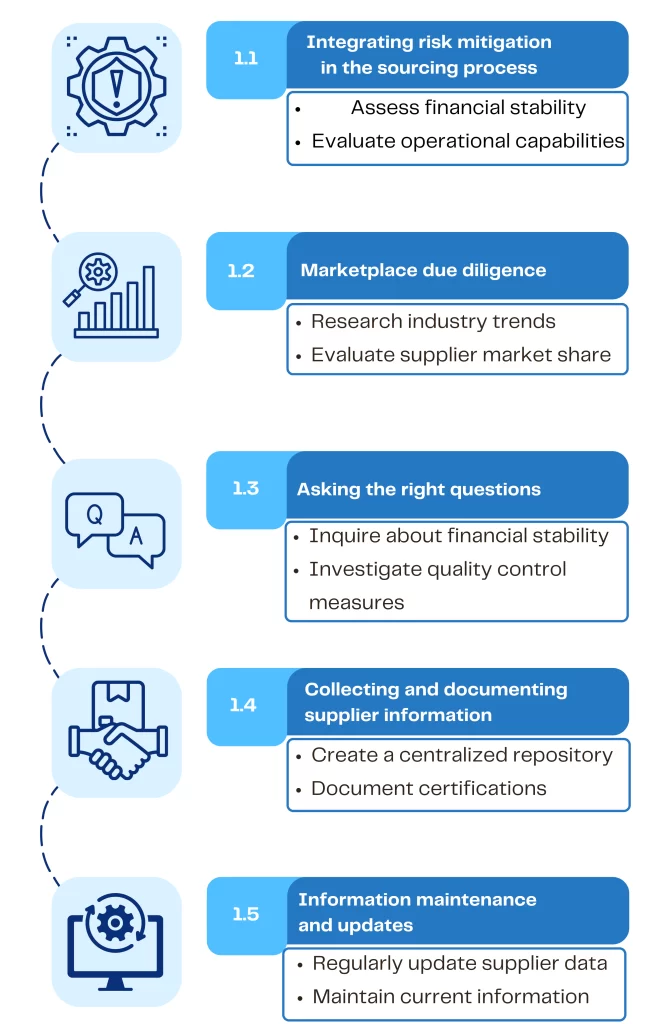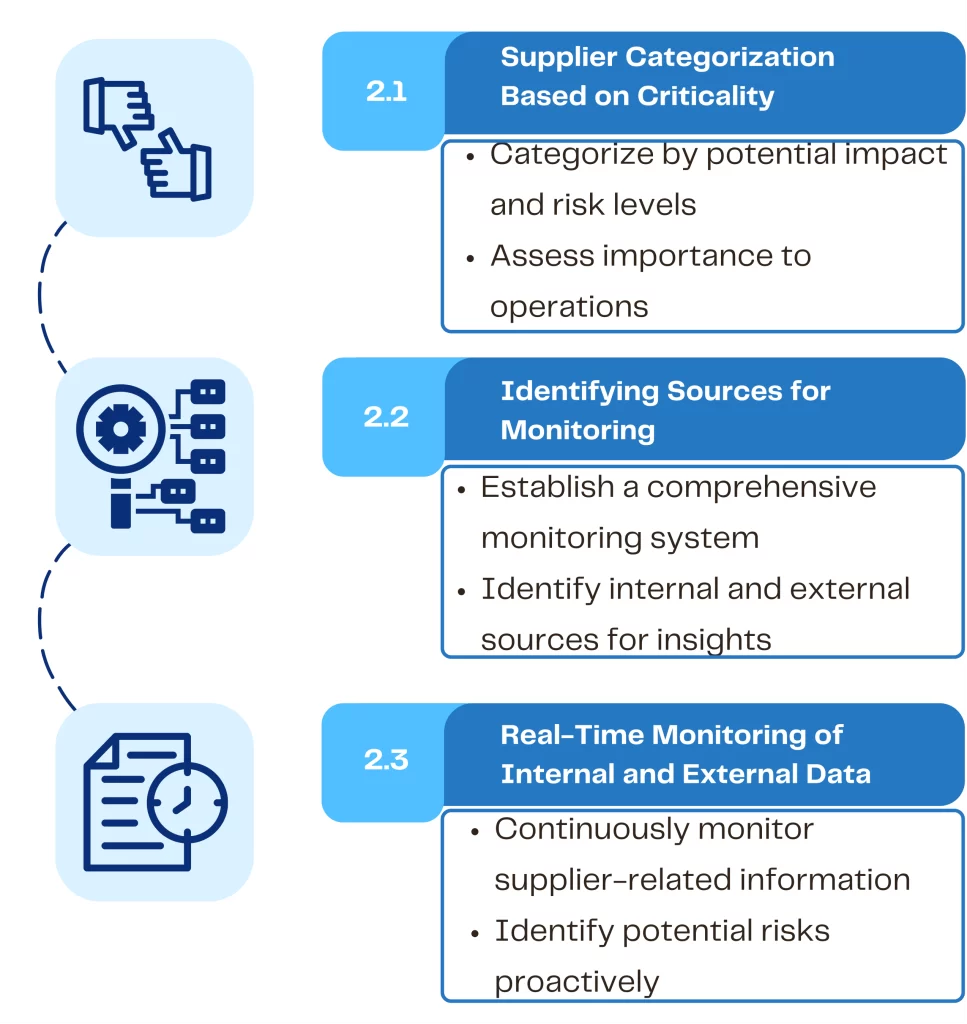
Crafting a Solid Baseline Without Historical Data: The EmpoweringCPO Way
What is Baseline? Baseline preparation is one of the most important phases during any Strategic Sourcing process.



In today’s global business environment, organizations are increasingly dependent on their suppliers for the smooth functioning of their operations. Supplier risk assessment is a crucial aspect of SCRM specially for best cost country sourcing, as it enables companies to identify potential risks associated with their suppliers and take necessary measures to mitigate them. An effective supplier risk assessment process ensures that businesses are working with reliable, efficient, and responsible suppliers, leading to improved supply chain performance, reduced costs, and enhanced customer satisfaction.
The failure of a supplier can have significant consequences for a business, affecting its reputation, profitability, and overall operations. Some potential consequences of supplier failure include:
A supplier’s inability to deliver goods or services on time may lead to production delays, inventory shortages, and increased lead times, causing a ripple effect across the entire supply chain.
In the event of a supplier failure, businesses may need to find alternative suppliers at short notice, which can lead to higher costs for goods or services.
Disruptions in the supply chain may cause delays in fulfilling customer orders, resulting in customer dissatisfaction and potential loss of business.
Supplier failure can expose businesses to legal and financial risks, such as breach of contract, penalties, and loss of revenue.
Working with unreliable suppliers can tarnish a company’s brand image and erode customer trust, impacting long-term growth and profitability.

Supplier Risk Assessment is a strategic approach to managing and mitigating risks associated with suppliers throughout the supply chain. It involves the systematic identification, assessment, and monitoring of supplier-related risks to minimize potential disruptions and ensure continuity of operations. By employing a comprehensive risk assessment process as part of SCRM, organizations can predict and prepare for possible adverse or favorable impacts on their supply chain, safeguarding their business interests and ensuring long-term success.
A proactive approach to managing supplier risk requires incorporating risk mitigation strategies into the sourcing process. This includes assessing potential suppliers’ financial stability, operational capabilities, and compliance with industry regulations.
Conducting thorough research on the marketplace allows organizations to identify suitable suppliers and evaluate their performance. This includes understanding industry trends, supplier market share, and potential risks associated with specific suppliers or regions.
Engaging in a detailed dialogue with suppliers helps uncover valuable information about their capabilities and risk factors. Examples of questions to ask include their financial stability, quality control measures, and business continuity plans in case of disruptions.
Maintaining a centralized repository of supplier information is essential for effective risk assessment. This involves collecting, aggregating, and documenting relevant supplier data, such as financial records, certifications, and performance metrics.
Regularly updating supplier information ensures that organizations are working with current and accurate data, allowing for more effective supply risk management and informed decision-making.

Suppliers should be categorized according to their potential impact on the business and associated risk levels. This can be done by evaluating factors such as the supplier’s importance to overall operations, contribution to product differentiation, and alignment with the company’s strategic objectives.
Establishing a comprehensive monitoring system requires identifying various sources of information, both internal and external, that can provide insights into supplier performance and risk factors. These sources may include news feeds, government control lists, court filings, internal surveys, and supplier references.
Continuous monitoring of supplier-related information enables organizations to identify potential risks and take proactive measures to mitigate them. By staying informed about changes in supplier performance, financial stability, or regulatory compliance, businesses can better manage supplier risk.

Transforming raw supplier data into actionable intelligence requires analyzing it based on factors such as corporate linkage, diversity, financial risks, spend analysis, and supplier performance aided by procurement savings tracker. This analysis helps organizations identify potential weaknesses and areas of concern in their supply chain.
Regularly tracking and comparing supplier performance data over time provides a more comprehensive view of supplier risk and performance trends. This enables organizations to identify patterns, anticipate potential issues, and make data-driven decisions to optimize their supply chain risk management.

Regularly evaluating suppliers’ performance, capabilities, and risk factors helps organizations stay informed about potential threats and opportunities in their supply chain.
Implementing robust risk monitoring systems enables organizations to proactively identify and manage supplier risk, ensuring supply chain resilience and continuity.
The impact of global events, such as pandemics, natural disasters, or geopolitical tensions, on the supply chain should be considered during risk assessments and contingency planning.
Estimating the potential cost of a supplier failure helps organizations weigh the benefits and risks of working with specific suppliers and prioritize risk mitigation efforts.
Cross-functional collaboration between procurement, finance, and operations teams is essential for effectively monitoring and addressing supplier risk.
Proactively preparing for potential supplier disruptions requires the development of contingency plans, such as identifying alternative suppliers and establishing backup sourcing strategies. These plans should be regularly updated to remain relevant and effective in the face of changing market conditions and supplier performance.
Identifying and qualifying alternate suppliers is a crucial component of risk mitigation planning. Continuously researching and evaluating new suppliers helps organizations maintain a supplier diversity program and ensures they are better prepared to respond to disruptions or other supply chain challenges.

EmpoweringCPO works closely with clients to effectively implement the comprehensive supplier risk assessment process, ensuring a seamless integration into the organization’s existing supply chain strategy and operations.
EmpoweringCPO provides a user-friendly, interactive dashboard that visually represents key supplier risk factors and highlights at-risk suppliers. This tool enables stakeholders to quickly identify and address potential issues, facilitating timely and informed decision-making.
In addition to identifying risks, EmpoweringCPO also assists clients in developing contingency plans and identifying alternate suppliers to minimize the potential impact of supplier disruptions. These plans are customized to the organization’s specific needs and requirements, ensuring a robust and resilient SCRM strategy.
EmpoweringCPO is committed to providing up-to-date and relevant information to clients. As part of this commitment, the team regularly updates the dashboard visuals and contingency plans to ensure they accurately reflect the current supply chain landscape and address any emerging risks or opportunities. This proactive approach enables organizations to adapt and respond to changing market conditions, maintaining a competitive edge in their respective industries.
1. Develop a comprehensive risk assessment framework: Establish a clear and well-defined process for assessing, monitoring, and mitigating supplier risks.
2. Collaborate with suppliers: Maintain open communication channels with suppliers to foster trust, transparency, and better supply risk management.
3. Continuously monitor supplier performance: Track key performance indicators (KPIs) to ensure suppliers meet expectations and address potential issues proactively.
4. Diversify the supplier base: Avoid over-dependence on a single supplier by diversifying your supply chain, thereby reducing the impact of potential disruptions.
5. Conduct regular audits and assessments: Perform periodic audits and assessments to ensure suppliers adhere to contractual agreements, industry standards, and regulatory requirements.
1. A global automotive manufacturer implemented a robust supplier risk assessment strategy, which included a comprehensive supplier evaluation and monitoring system. This approach allowed the company to identify and mitigate potential risks, resulting in significant cost savings and improved supply chain resilience.
2. A leading pharmaceutical company used advanced data analytics and supplier segmentation techniques to identify high-risk suppliers and prioritize risk mitigation efforts. By focusing on the most critical suppliers, the company was able to reduce supply chain disruptions and improve overall performance.
Advanced spend analytics dashboard and tools can help organizations identify patterns and trends in supplier performance, enabling proactive risk management.
AI-powered solutions can be used to automate risk assessments, monitor supplier performance, and predict potential disruptions.
Blockchain can provide increased transparency and traceability in the supply chain, enabling better supply risk management and more informed decision-making.
Implement stringent food safety standards and traceability measures to mitigate risks associated with food contamination and product recalls.
Ensure compliance with strict regulatory requirements, maintain robust quality management systems, and invest in cybersecurity measures to protect sensitive information.
Develop flexible strategic sourcing services to adapt to changing consumer demands and market conditions, and invest in advanced inventory management systems to minimize stockouts and overstock situations.
The increasingly interconnected global economy presents new challenges in managing geopolitical risks, such as trade disputes and political instability.
Organizations must address the growing importance of environmental, social, and governance (ESG) factors in their supply chain risk management strategies.
Companies must keep up with changing regulations and standards to ensure compliance and minimize legal and reputational risks.
The growing reliance on digital technologies exposes organizations to increased cybersecurity risks, necessitating robust measures to protect sensitive information and systems.
Future trends in supply risk management will likely focus on building more resilient supply chains that can adapt and recover quickly from disruptions.
If your organization is looking to develop and implement a successful supplier risk assessment program, EmpoweringCPO is the ideal partner for procurement outsourcing services to help you achieve your goals. Their team of procurement professionals possesses the expertise, experience, and commitment to excellence required to ensure the success of your SCRM program. Contact EmpoweringCPO today to learn more about how they can help your organization build your supplier risk assessment program, and subsequently improved, reliable and efficient supply chain performance.
These are quite recently the absolute most normal inquiries we get inquired.
Supplier Risk Assessment is a program that helps mitigate risk associated with suppliers by identifying, quantifying, and providing for remedies or safeguards to protect an organization from potential disruptions to the supply chain.
The risks associated with supplier failure include immediate revenue loss, interruption of production, additional costs to resources, delays of major capital investment projects, requirement for increased management time, loss of customer goodwill, reputational damage, potential loss of any competitive advantage, and adverse stakeholder reactions like analyst downgrades.
Supplier Risk Assessment can help your business identify and mitigate the risks associated with supplier failure, protect your supply chain from disruptions, and maintain business continuity.
The four steps adopted by EmpoweringCPO in supplier risk assessment are collecting data during the sourcing process and validating it by third-party sources, classifying vendors as per risk type and determining information source to monitor, continuing and repetitive analysis to trend the information and identify potential failure, and preparing mitigation plans, documenting competitive suppliers, continually researching for new suppliers, and initiating their approval process.
EmpoweringCPO integrates risk mitigation and management in the sourcing process by conducting marketplace due diligence, asking the right questions, collecting and documenting all information about suppliers, and verifying supplier information.
Vendors are classified as per risk type based on their criticality, which is identified based on some factors.
EmpoweringCPO monitors both external and internal data in real-time to identify and quantify supplier risk.
EmpoweringCPO analyzes the data collected in the previous steps based on several parameters and trends the analyzed information over time to get a bigger picture of supplier performance over a period of time.
EmpoweringCPO will provide a dashboard that visually represents the critical factors and ‘at-risk’ suppliers, as well as a visual summary of the position of supplier(s) risk.
Working with EmpoweringCPO for your supplier risk assessment needs can help you identify and mitigate the risks associated with supplier failure, protect your supply chain from disruptions, and maintain business continuity, ultimately leading to increased efficiency and profitability for your business.

What is Baseline? Baseline preparation is one of the most important phases during any Strategic Sourcing process.

A cartel is formed when businesses agree to act together for an anti-competitive purpose instead of competing against each other.

Spot Buying is for immediate, Ad-Hoc & one-off purchases. It’s estimated that around 40% of the company’s indirect spending is from spot buying.
Compliance management is very critical as otherwise the procurement organization may run into a scenario where there is a huge gap between realized savings and reported savings. Many procurement functions estimate large savings numbers when contracts are signed. They also invest significant time and effort in negotiating contracts for necessary goods and services, only to have a third or more of their purchasing dollars flow outside those deals. Some of the obvious fall-outs of non-compliance and maverick purchases are:
As compared to the current contract that was finalized after the sourcing process, the tool helps in tracking:
The objective of this tool is to ensure that the orders are placed only with the vendors that were shortlisted after the sourcing process and at the same price that was agreed upon and negotiated during and after the strategic sourcing process.